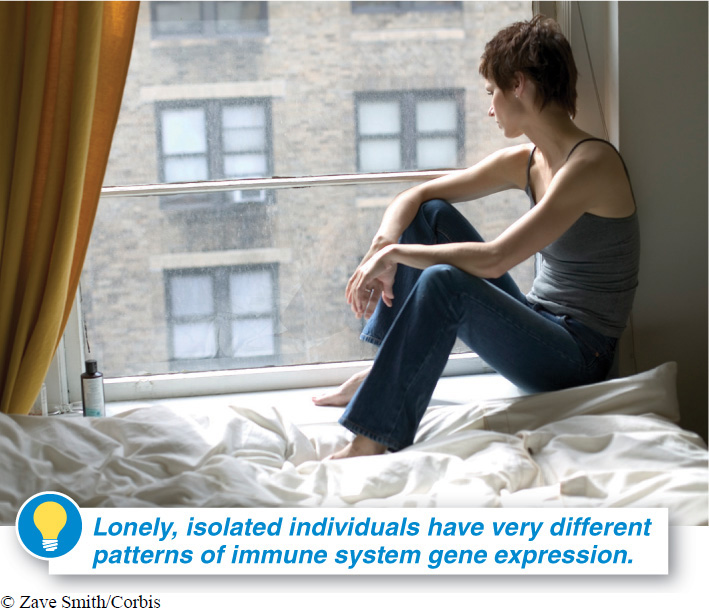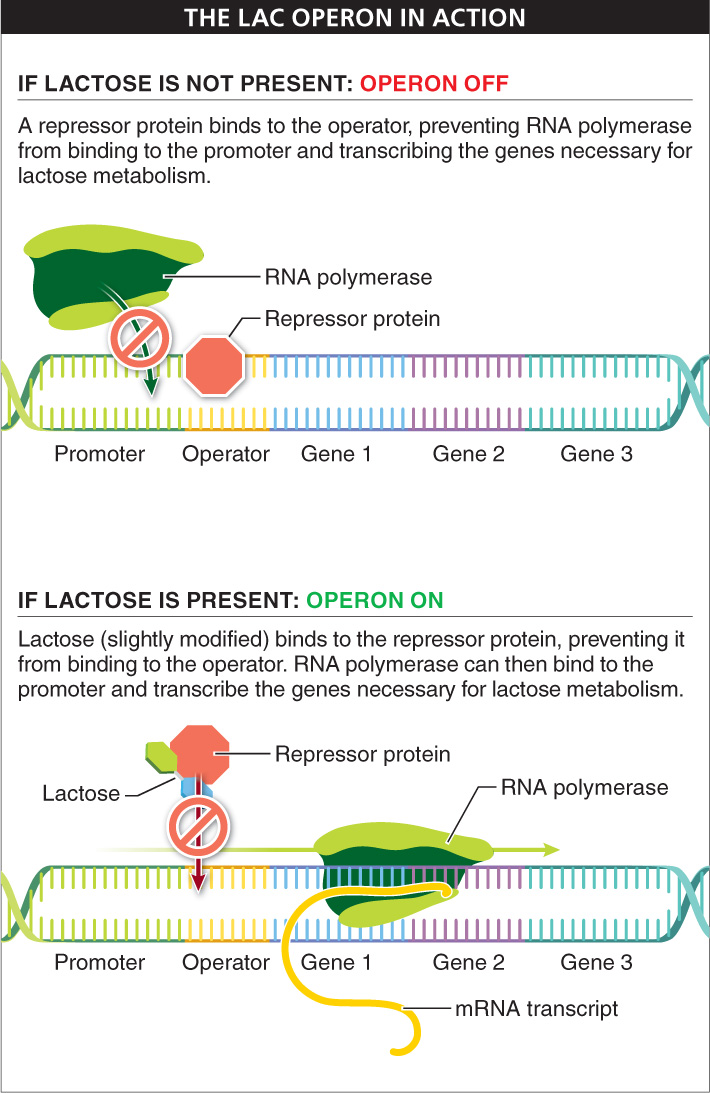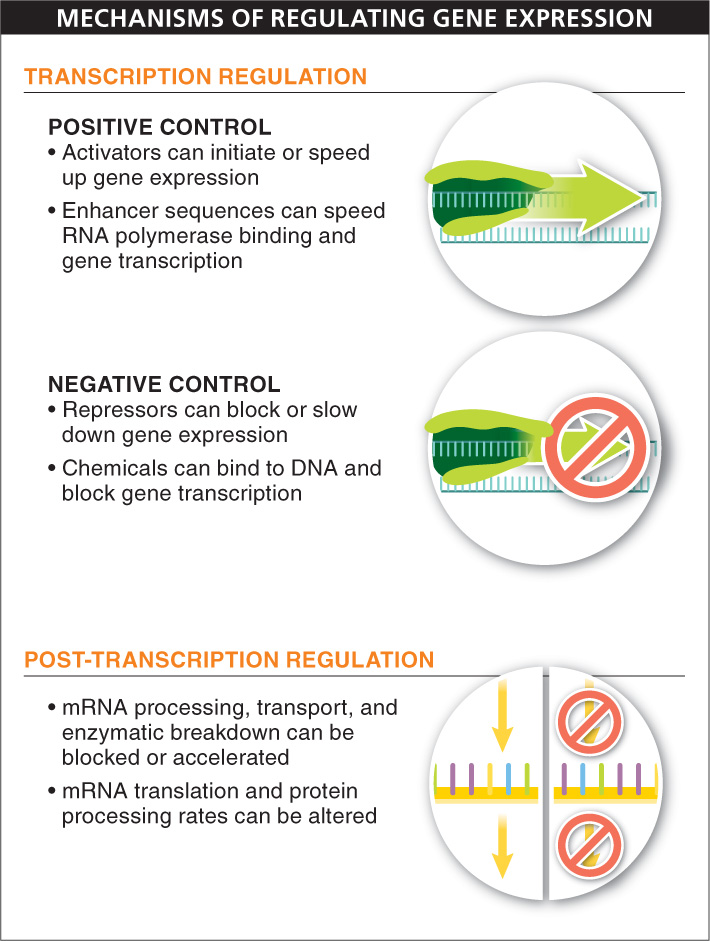5.8: Genes are regulated in several ways.
Why do some people get sick more than others? Why is one person taller or shorter than another? More generally, what makes us look and act the way we do? We say that our health, growth, and development are the result of interactions between our genes and our environment. But how do our genes and our environment actually interact?
194
It matters which genes a person has, but carrying a gene is not the only thing that matters when it comes to gene expression—the production of the protein that the gene’s sequence codes for. A person’s traits also depend on gene regulation, whether a gene is turned on—
A powerful tool in the study of gene regulation is the microarray, a small chip that looks like a microscope slide that can be used to monitor the expression levels of thousands of genes simultaneously. Taking cells from one part of the body, researchers examine gene expression in that tissue. Microarrays are particularly useful in exploring how gene expression differs in response to an illness, or the treatment of an illness, or in response to aging.
For example, in a five-
Individuals in the “lonely” group had impaired transcription (decreased activity) of some genes associated with an effective stress response. They also had increased activity in genes associated with inflammatory processes that are implicated in a variety of diseases (FIGURE 5-16). Related studies have shown a similarly reduced immune function among stressed-

Controlling gene expression Cells have a wide variety of mechanisms by which they can control when individual genes are expressed. One of the main ways expression is controlled is by proteins called transcription factors, which bind to specific sequences in the DNA called regulatory sites, which are often located in front of genes. The regulation may be “positive control,” in which binding of the regulatory protein initiates or speeds up gene expression, or “negative control,” in which the protein slows or blocks gene expression.
195
Regulatory proteins can be produced by the same cell whose DNA they are regulating, or they may come from nearby cells. During the initial development of an organism, for example, gene regulation is extremely important in directing cells to differentiate into one type of tissue—
Prokaryotic gene control and the lac operon Regulation may also be influenced by the nutrients an organism takes in. One well-
The absorption and digestion of lactose, however, requires the expression of three genes, and bacteria do not waste their energy transcribing these genes, translating the proteins, folding them, and sending them to the correct destinations unless lactose is actually present. That regulation is accomplished with a set of regulatory sequences called an operon, which is a group of several genes and the elements that control their expression as a unit, all within one continuous segment of the cell’s DNA (FIGURE 5-17).

Promoter. For a gene to be transcribed, RNA polymerase recognizes and binds to the promoter region, the specific sequence of nucleotides in the DNA that signals the beginning of the gene.
Operator. A molecule called a repressor protein can bind to the operator, the regulatory portion of the DNA, and by doing so it blocks RNA polymerase from transcribing the genes necessary for lactose metabolism.
Regulatory gene. The regulatory gene codes for the repressor protein that, when bound to the operator region, does the blocking of RNA polymerase’s binding to the promoter site. The regulatory gene may be located in the operon it regulates or elsewhere in the genome.
In the absence of glucose (more on this below), here’s how this operon (called the “lac operon”) functions. If lactose is not present: (1) The regulatory gene produces the repressor protein. (2) The repressor protein binds to the operator region. And (3) RNA polymerase is blocked from transcribing the lactose metabolism genes (FIGURE 5-18).

If, on the other hand, lactose is present: (1) The regulatory gene produces the repressor protein. (2) Lactose binds to the repressor protein, altering its shape so that it can no longer bind to the operator. And (3) with no repressor bound to the DNA, RNA polymerase binds to the promoter and transcribes the genes necessary for lactose metabolism.
Note that the lac operon can be switched on only in the absence of glucose. If no glucose is present, a regulatory protein called an activator helps the DNA unwind in the vicinity of the lac operon, enabling RNA polymerase to bind and transcribe genes. When glucose is present, however, the activator protein cannot bind to the DNA, and this prevents RNA polymerase from binding to and transcribing the lactose metabolism genes.
196
Eukaryotic gene control There are many other ways that genes can be regulated, besides operons. Many eukaryotes, for example, have enhancer sequences that increase transcription rates (positive control). Often far from the gene they regulate, these sequences, after binding a regulatory protein, bind transcription factors associated with RNA polymerase and enhance the rate at which the RNA polymerase binds to a promoter and transcribes a gene.
Additional mechanisms of gene control include the binding of chemicals to DNA that can block genes from being transcribed (negative control) and the regulation of mRNA. Messenger RNA can be regulated by altering its processing and transport, or by altering the rate at which mRNA is broken down in the cytoplasm. Translation of mRNAs can be regulated, too, as can the processing of proteins following translation (FIGURE 5-19).

TAKE-HOME MESSAGE 5.8
Environmental signals influence the turning on and turning off of genes. By binding to DNA, regulatory proteins can block or facilitate the binding of RNA polymerase and the subsequent transcription of genes. Regulation of gene expression also can occur in a variety of other ways that enhance or impede transcription, or alter mRNA’s longevity and rate of degradation, or influence translation or protein processing.
Briefly, what happens to the lac operon in both the presence and absence of lactose?
197